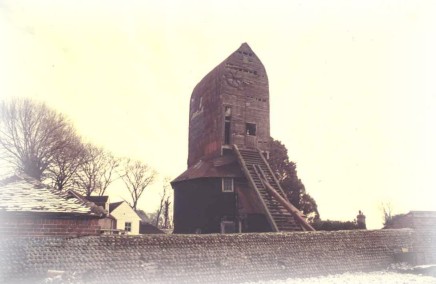A windmill
may have existed in what is now Windmill Hill as early as
Elizabethan times, when a survey of the Castle estate mentions "Wyndmylhyll".
In 1769, the windmill was tenanted by one John Edwards, and the
mill is on Yeakell and Gardner's map of 1783. In 1814 the old mill was
pulled down and "an immense post mill with an enormous
tailpole" was erected on the same site.

The Windmill before restoration
Steam power was installed in 1894, but steam working ceased in
1913. (See Richard and Richard McDermott, The Standing
Windmills of East Sussex [Betford Publications, n.d.],
61.) There is a Windmill Hill Windmill Trust
and a preservation society, the Friends of the Windmill Hill
Windmill. To
see the Trust's website, CLICK HERE.
In December 2001, the Heritage Lottery Fund contributed £577,000
towards the restoration. "The
windmill has now been dismantled and taken to the millwrights' for
repair. Photographs of the roof coming off are now on the
website." To see
ukvillages.co.uk's webpage on the Windmill Hill Windmill,
CLICK
HERE
The School House in Windmill Hill appears
originally to have been built in the early Seventeenth Century as a
farmhouse. It was purchased in 1766 by Edward Allfree, who founded
there a school which had the distinction of being the
first co-educational boarding school in Britain -
pre-dating by some 125 years the founding of Bedales which currently
lays claim to that title.
Allfree had previously been a
surveyor and draughtsman, and these subjects took a prominent place
in the boys' curriculum. His wife Elizabeth taught the girls
needlework, music and French. The experiment proved an immediate
success, and over 40 children were registered at any given time as
boarders, along with many local day pupils. The school was renowned
for its extravagant balls, intended as
recruitment drives, and for its excellent food,
which earned it the title of "Gluttony Hall". In 1777,
fees for girls were 13 guineas - "tea and sugar included"
- while boys paid 16 guineas, which included special tuition for
university entrance.
The school flourished into the 1850s under
the direction of Allfree's eldest son. Afterwards it passed
through a succession of hands until competition from the free
local church schools led to its closure at about the
time of the First World War. The Allfree dynasty continued
for many years elsewhere, however, as five of Edward Allfree's 14
children went on to found schools in their own right.
Little physical evidence remains now of the
school's activities, but in the County Records Office at Lewes there
survives an exercise book which bears witness to the excellent
standards of draughtsmanship practised by the boys under Allfree's
tutelage.
